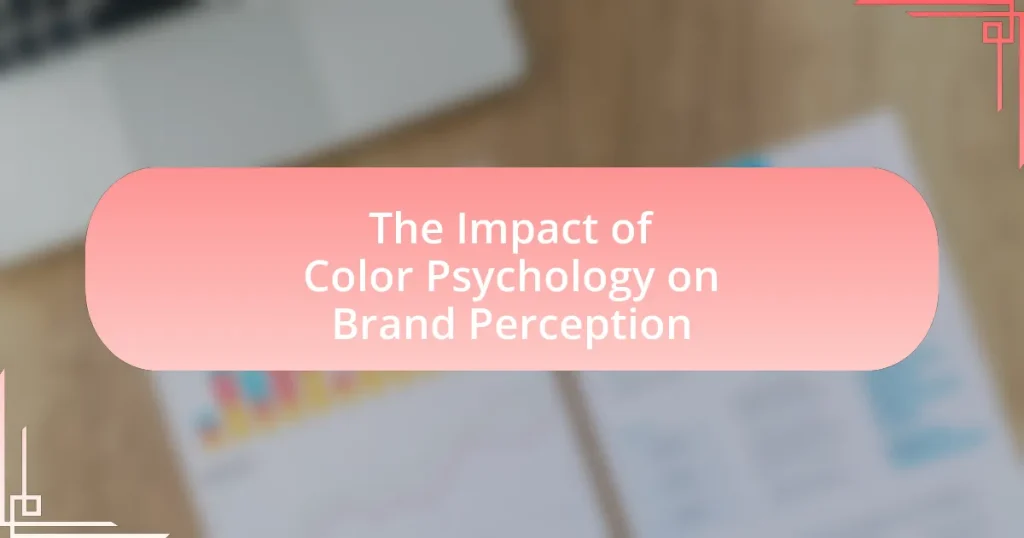The article examines the impact of color psychology on brand perception, highlighting how colors influence consumer emotions and behaviors. It discusses the psychological effects of different colors, such as blue conveying trust and red evoking excitement, and emphasizes the importance of color choice in branding for enhancing recognition and loyalty. The article also addresses cultural differences in color interpretation, potential pitfalls of color usage, and best practices for brands to align their color strategies with target audiences, ultimately demonstrating the critical role of color in shaping consumer perceptions and decision-making.

What is the Impact of Color Psychology on Brand Perception?
Color psychology significantly influences brand perception by affecting consumer emotions and behaviors. Research indicates that colors can evoke specific feelings; for instance, blue often conveys trust and reliability, while red can evoke excitement and urgency. A study by the Institute for Color Research found that up to 90% of snap judgments made about products can be based on color alone, highlighting its critical role in branding. Additionally, brands that align their color schemes with their target audience’s preferences can enhance brand recognition and loyalty, as seen in successful companies like Coca-Cola and Tiffany & Co., which effectively use red and blue, respectively, to reinforce their brand identities.
How does color psychology influence consumer behavior?
Color psychology significantly influences consumer behavior by affecting emotions and perceptions associated with brands. For instance, research indicates that colors can evoke specific feelings; blue often conveys trust and reliability, while red can stimulate excitement and urgency. A study by Satyendra Singh published in the journal “Management Decision” found that up to 90% of snap judgments made about products can be based on color alone. This demonstrates that color choices in branding can directly impact consumer decisions, leading to increased engagement and sales.
What are the psychological effects of different colors?
Different colors evoke specific psychological effects that influence emotions and behaviors. For instance, red often stimulates excitement and urgency, making it effective in marketing to encourage quick decisions. Blue, on the other hand, is associated with calmness and trust, which is why many financial institutions use it to convey reliability. Yellow can evoke feelings of happiness and optimism, but excessive use may lead to anxiety. Green is linked to nature and tranquility, promoting a sense of balance and health. Research by Satyendra Singh in the “Management Decision” journal indicates that color can increase brand recognition by up to 80%, demonstrating its significant impact on consumer perception and decision-making.
How do colors evoke emotions in consumers?
Colors evoke emotions in consumers by triggering psychological responses that influence their perceptions and behaviors. For instance, research indicates that warm colors like red and orange can create feelings of excitement and urgency, often leading to increased impulse buying. In contrast, cool colors such as blue and green tend to evoke calmness and trust, which can enhance brand loyalty. A study published in the journal “Management Decision” found that up to 90% of snap judgments about products can be based on color alone, highlighting the significant role color plays in consumer decision-making.
Why is color choice important for branding?
Color choice is important for branding because it significantly influences consumer perception and emotional response. Research indicates that colors can increase brand recognition by up to 80%, as they evoke specific feelings and associations that align with brand identity. For instance, blue is often associated with trust and reliability, making it a popular choice for financial institutions. This psychological impact of color can enhance customer loyalty and differentiate a brand in a competitive market.
What role does color play in brand recognition?
Color significantly influences brand recognition by enhancing memorability and emotional connection. Research indicates that color can increase brand recognition by up to 80%, as it helps consumers associate specific colors with particular brands, creating a visual identity that stands out in a crowded marketplace. For instance, brands like Coca-Cola and McDonald’s effectively use red and yellow, respectively, to evoke feelings of excitement and happiness, which reinforces their brand image and encourages consumer loyalty.
How can color enhance brand identity?
Color enhances brand identity by creating emotional connections and influencing consumer perceptions. Research indicates that color can increase brand recognition by up to 80%, as it helps convey the brand’s personality and values. For instance, blue is often associated with trust and reliability, making it a popular choice for financial institutions, while red evokes excitement and urgency, frequently used in food and retail sectors. These associations are rooted in color psychology, which shows that specific colors can trigger particular feelings and behaviors in consumers, thereby reinforcing brand identity and loyalty.
What are the key principles of color psychology in branding?
The key principles of color psychology in branding include the emotional associations of colors, the influence of color on consumer behavior, and the importance of color consistency. Colors evoke specific emotions; for example, blue often conveys trust and reliability, while red can evoke excitement and urgency. Research indicates that 85% of consumers make purchasing decisions based on color, highlighting its significant impact on consumer behavior. Additionally, maintaining color consistency across branding elements strengthens brand recognition, as consistent use of color can increase brand recognition by up to 80%. These principles underscore the critical role color plays in shaping brand perception and influencing consumer choices.
How do cultural differences affect color perception?
Cultural differences significantly affect color perception by influencing how individuals interpret and respond to colors based on their cultural backgrounds. For instance, in Western cultures, white is often associated with purity and weddings, while in many Eastern cultures, it symbolizes mourning and funerals. This divergence in color symbolism can impact branding strategies; companies must consider these cultural associations to effectively communicate their messages. Research by Aslam (2006) in the Journal of Marketing Management highlights that color preferences vary across cultures, with specific colors eliciting different emotional responses and meanings. Thus, understanding these cultural nuances is crucial for brands aiming to resonate with diverse audiences.
What are the common color associations in marketing?
Common color associations in marketing include specific meanings attributed to various colors that influence consumer perception and behavior. For instance, red often evokes feelings of excitement and urgency, making it effective for clearance sales. Blue is associated with trust and dependability, which is why many financial institutions use it in branding. Green represents health and tranquility, commonly used by eco-friendly brands. Yellow conveys optimism and warmth, often used to grab attention. Black signifies luxury and sophistication, frequently seen in high-end products. These associations are supported by studies in color psychology, such as those by the Institute for Color Research, which found that color can increase brand recognition by up to 80%.
How can brands effectively use color psychology?
Brands can effectively use color psychology by strategically selecting colors that evoke specific emotions and associations relevant to their target audience. For instance, blue is often associated with trust and reliability, making it a popular choice for financial institutions, while red can evoke excitement and urgency, commonly used in sales promotions. Research indicates that 85% of consumers make purchasing decisions based on color, highlighting the importance of color in brand identity and consumer perception. By aligning their color choices with the psychological effects of colors, brands can enhance their messaging and influence consumer behavior effectively.
What strategies can brands implement to choose effective colors?
Brands can implement several strategies to choose effective colors by understanding color psychology and aligning colors with their brand identity. First, brands should analyze their target audience’s preferences and cultural associations with colors, as different demographics may respond uniquely to specific hues. For instance, research indicates that blue is often associated with trust and reliability, making it a popular choice for financial institutions.
Next, brands can conduct A/B testing to evaluate how different color schemes impact consumer behavior and engagement. This empirical approach allows brands to gather data on which colors resonate best with their audience, leading to informed decisions. Additionally, brands should consider the emotional responses elicited by colors; for example, warm colors like red and orange can evoke excitement, while cool colors like green and blue can promote calmness.
Finally, consistency in color usage across all branding materials reinforces brand recognition and loyalty. According to a study by the University of Loyola, Maryland, color can increase brand recognition by up to 80%. By strategically selecting colors that reflect their values and appeal to their audience, brands can enhance their overall perception and effectiveness in the market.
How can brands test color effectiveness in their marketing?
Brands can test color effectiveness in their marketing through A/B testing, where different color schemes are applied to marketing materials and audience responses are measured. This method allows brands to analyze metrics such as click-through rates, conversion rates, and customer engagement levels associated with each color variant. For instance, a study by the Institute for Color Research found that color can increase brand recognition by up to 80%, highlighting the importance of color choices in marketing strategies. By systematically evaluating the performance of various colors, brands can make data-driven decisions that enhance their marketing effectiveness.
What are the potential pitfalls of color usage in branding?
The potential pitfalls of color usage in branding include misalignment with brand identity, cultural misunderstandings, and emotional misinterpretations. Misalignment occurs when the chosen colors do not reflect the brand’s values or target audience, leading to confusion about the brand’s message. For example, a luxury brand using bright, playful colors may undermine its premium positioning. Cultural misunderstandings arise when colors have different meanings in various cultures; for instance, white symbolizes purity in Western cultures but can represent mourning in some Eastern cultures. Emotional misinterpretations can occur if colors evoke unintended feelings; for example, red can signify excitement but may also be associated with danger. These pitfalls can negatively impact brand perception and customer engagement.
How can misinterpretation of colors harm brand perception?
Misinterpretation of colors can significantly harm brand perception by leading to negative associations and misunderstandings about a brand’s identity. For instance, if a brand uses red, which typically signifies excitement or passion, but consumers interpret it as aggressive or alarming, this can create a disconnect between the brand’s intended message and consumer perception. Research indicates that 85% of consumers make purchasing decisions based on color, highlighting the critical role color plays in brand recognition and emotional response. Therefore, incorrect color interpretation can result in diminished brand loyalty and trust, ultimately affecting sales and market position.
What are the risks of color over-saturation in branding?
Color over-saturation in branding can lead to brand fatigue, where consumers become desensitized to the brand’s message due to excessive exposure to vibrant colors. This desensitization can diminish emotional engagement and reduce brand recall, ultimately impacting consumer loyalty. Research indicates that brands using overly saturated colors may also be perceived as aggressive or overwhelming, which can alienate potential customers. For instance, a study published in the Journal of Consumer Research found that brands with high color saturation were often associated with negative emotions, leading to a decrease in purchase intent. Thus, the risks of color over-saturation include diminished brand perception, reduced emotional connection, and potential alienation of the target audience.
What best practices should brands follow regarding color psychology?
Brands should select colors that align with their brand identity and target audience to effectively leverage color psychology. Research indicates that colors evoke specific emotions and associations; for example, blue often conveys trust and reliability, while red can evoke excitement and urgency. Brands should also consider cultural differences in color perception, as colors may have varying meanings across different cultures. Additionally, consistency in color usage across all branding materials enhances brand recognition, with studies showing that consistent branding can increase revenue by up to 23%. Finally, testing color choices through A/B testing can provide data-driven insights into consumer preferences, allowing brands to refine their color strategies effectively.
How can brands align their color choices with their target audience?
Brands can align their color choices with their target audience by understanding the psychological effects of colors and the preferences of their demographic. Research indicates that colors evoke specific emotions and associations; for example, blue is often linked to trust and dependability, making it a popular choice for financial institutions. By conducting market research, brands can identify the color preferences of their target audience, ensuring that their color palette resonates with the values and emotions that the audience seeks. Additionally, studies show that 85% of consumers make purchasing decisions based on color, highlighting the importance of strategic color selection in brand identity.
What tools can brands use to analyze color impact on perception?
Brands can use tools such as color analysis software, eye-tracking technology, and surveys to analyze color impact on perception. Color analysis software, like Adobe Color and Coolors, allows brands to create and evaluate color palettes based on psychological principles. Eye-tracking technology, utilized in studies by companies like Tobii, measures where consumers focus their attention, revealing how colors influence visual engagement. Surveys and A/B testing can provide direct feedback from consumers regarding their emotional responses to different colors, helping brands understand the psychological effects of color choices.


